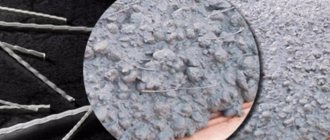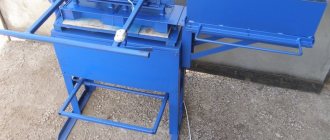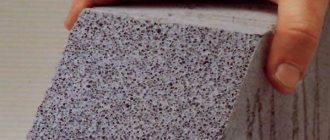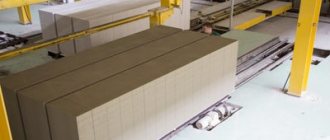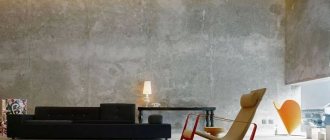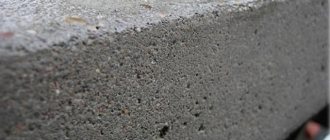The use of cement mortar is widely used for external and internal work. The standard color of this solution is gray. To give a decorative look, the cement surface can be painted in different colors or at the stage of preparing the solution, add a cement dye to it - this will give the solution a more saturated and uniform color.
Adding pigments to the solution extends the service life of the painted cement surface. If you paint gray concrete, then this decorative layer will last a long time.
Types of dyes
How to make colored concrete? This was said earlier - paint a dried gray surface or add dye at the stage of mixing the solution. If there is such an element as a concrete retaining wall on a suburban area, then you can simply make it decorative - to do this, you should paint its surface. It is necessary to use a deep penetration coloring composition that is absorbed into the surface of the concrete by 1-2 mm and colors its structure.
The intensity and durability of the color depends on the depth of penetration of the dye. It will not be afraid of natural influences in the form of sun, moisture and wind, as well as mechanical influences.
Making a product from an already painted solution will create a decorative, durable surface that does not require touch-up. However, it is worth considering that pigments are not cheap, so making large elements will cost a pretty penny.
Acid
This is the most common method of painting concrete structures. This dye is transparent and harmless to humans and the environment. Coloring occurs as a result of a chemical reaction with cement, which then acquires the required shade.
Depending on what color the cement is (white or gray), the final result will depend. The solution requires the use of a solvent, fixing additives and an adhesive.
In order to give white cement a bright, rich color, it is necessary to dilute the mixed dry components with liquid. The base for painting is treated with a solvent. The surface, cleared of dust and dirt, is coated with paint using a spray gun or an acid-resistant brush that does not have metal elements. You must work using personal protective equipment.
After at least 6 hours have passed, the remaining paint and acid must be removed with water and the surface thoroughly dried for 24 hours. A similar painting method is used for a stylized aged surface or imitation of natural stone.
Using an acid dye, small architectural forms made of concrete, sidewalk tiles or paving stones are painted. The surface painted in this way has a long service life.
On video: review of acid dyes.
Acrylic
How to paint concrete so that the colors are bright and saturated, and the service life of the material remains durable? Pay attention to the acrylic dye. Most often it is used for painting floors or wall surfaces. The required shade, even black, can be purchased at a hardware store.
This type of dye is harmless to humans - you can work with it indoors or outdoors. Acrylic dries quickly. To obtain a rich color, painting can be done again.
Tools you can use are brushes, sponges, rollers or sprayers. The coating can be called durable provided that the work was carried out with high-quality acrylic, otherwise the painted layer will peel off over time and peel off from the base.
Simple dye
A distinctive feature of this type of dye is the ease of its preparation, as well as the ability to obtain a large number of shades. Thanks to this dye, especially bright concrete elements are obtained. This type of paint has an affordable price, but it also has disadvantages - if the quality is poor, the painted elements fade under the influence of sunlight and are not resistant to temperature changes.
Simple dye is used mainly for decorating rooms. A ready-to-use composition is obtained by mixing powder, water or solvent. After application and drying, there is no need to rinse off any remaining solution with water.
Dry dye
This type of dye is available in a wide selection of colors and shades. The color of the powder corresponds to the color that the painted surface will acquire. This dye is able to adequately withstand the effects of natural phenomena in the form of precipitation and temperature changes.
The only condition is that the concrete surface must be new, that is, it has not been painted or treated in any way before. In addition to its decorative qualities, this dye helps strengthen the concrete structure.
When purchasing dry dye, it is important to take into account the uniformity of the composition and uniform coloring. The substances included in the powder cannot be dissolved with water, because when using a solvent they will settle to the bottom. This applies to ocher, umber or white.
This dye is applied using a trowel or spatula. It is necessary to periodically stir the solution so that the surface consists of a dense, opaque layer.
Color additives
These are dyes that allow you to color cement mortar at the stage of its preparation. Colored concrete additives have a powdery or liquid consistency. They are characterized by a predominance of light and pastel colors. The service life of this dye is equal to the service life of the concrete structure.
Instructions for painting concrete with acid dyes
Acid paint for concrete contains hazardous components. The application process is accompanied by the evaporation of harmful substances into the air.
- According to the instructions, the coating is heated to 30-45 0C, so you need to work strictly following safety rules.
- For work, wear a special rubberized uniform, since when it spreads over the surface being treated, splashes fly, and the composition contains acid, alkali or salt.
- Prepare ingredients and mix solutions in plastic buckets with wide sides.
- For application, use special equipment, power tools and personal protective equipment.
Positive qualities of colored cement
Colored cement used in flooring will not require restoration or periodic touch-up. After the top layer of such a concrete floor is erased, its color will remain consistently saturated. By mixing concrete pigments with your own hands in the required proportions, you can achieve a wide range of colors and shades.
Iron oxide dyes for cement mortar are the most popular and safe. This is a synthetic material that is economical in consumption.
Before painting the cement mortar, it is necessary to take into account the possible disadvantages of this measure. Over time, the concrete floor may turn yellow, causing erosion and contamination. If you want to make a large-area floor out of colored cement, it is important to take into account the cost of the issue. If you lay out garden paths or small fragments from colored concrete, it will be cheaper.
Surface treatment with hardening impregnation
At this stage, the concrete is treated with a special compound that secures the applied layer of paint. High-quality impregnation creates an invisible film and guarantees the preservation of brightness and depth of shade. Impregnation not only affects the color component of the renewed coating, but also strengthens the porous structure.
A protective layer with a polymer or inorganic base increases the guaranteed service life. Epoxy resins and polyurethane contained in the impregnation structure the top layer with a lime component.
- Impregnation helps to withstand sudden temperature changes.
- Strengthens the structure for resistance to chemical and mechanical stress.
- Helps remove natural concrete dust.
What to consider when preparing the solution
To prepare a dye for concrete with your own hands, you need to take into account the color of the concrete base. White concrete can be lightened by adding titanium dioxide to it in a proportion of 1-2%. And in the production of paving slabs, it is recommended to use mineral-based dyes in a proportion of 1-5%.
In order to prepare a pigment for concrete with your own hands, it is important to consider that the dyes must withstand the effects of alkalis, atmospheric conditions and direct solar radiation.
Before painting the cement mortar, it is necessary to study the range of shades that powder paint provides. The green tint comes from chromium oxide, red from iron oxide, and black from manganese peroxide. White pigments are obtained using limestone and chalk.
Recommendations from experts (2 videos)
Different types of pigments for cement (23 photos)
What factors affect the color of acid staining?
The color of the surface to be painted in most cases depends on the concentration of the solution and the method of applying the composition to the slab being treated.
The interaction of chemical components depends on several factors:
- If additives are included in the concrete solution.
- The quality of cement, as well as the ratio of the working mixture.
- Silicon or granite crushed stone is resistant to the innovative paint composition. If they are included in the working batch, the coloring of the concrete will be uneven - fragments of stones will stand out against the general background and interfere with the normal course of the chemical reaction.
- The total ambient humidity at the time of painting, the ratio of dry matter and water in the concrete slab.
Before starting work, it is recommended to do a test to check how uniform and high-quality the updated coating will be. It may be necessary to increase the concentration of some components and reduce the percentage of others to obtain a bright shade.
Price
Depending on the type of color, its price will vary:
- Powder pigments are the cheapest (from 20 to 300 rubles per 1 kg).
- Acid compounds will cost a little more (from 110 to 400 rubles).
- The most expensive are pastes and various emulsions (from 200 rubles).
Imported dyes will cost from 550 rubles per bag (2 kg), domestic ones will cost 15% less.
Important! If the composition is too cheap, then most likely it will fade and wear off quite quickly.
If we talk about the best colors, then you should pay attention to the SikaCim Color S brand. The manufacturer offers a fairly wide color palette of pigments that are suitable for both internal and external treatment of concrete surfaces (including sidewalk paths and platforms). The consumption of SikaCim Color S ranges from 0.8 to 5.0% (depending on the intensity of the shade) of the total mass of the cement mortar. The cost of such a dye will be from 600 rubles per package (0.7 kg).
Manufacturers also have proven themselves well: Bayferrox Lanxess (Germany), Precolor AS (Czech Republic) and Cathay Industries (Germany).
Tools, painting equipment, protective equipment
The technology for painting concrete involves the use of spray guns, brushes, rollers, and spatulas.
Brushes
The tool is necessary for applying paints and primers. Brushes are made from several materials - synthetic fiber, bristles, horsehair . The best application is provided by samples based on animal hair, but they quickly lose elasticity and are generally short-lived. For large volumes of work, it is recommended to use brushes based on bristles and horsehair. Synthetic analogues are cheaper, but worse in shading and paint selection.
The work will require round brushes with a long handle for processing large surfaces, paneled and fluted brushes for processing junctions, hard-to-reach places and end-grain brushes for creating a rough structure on the finishing layer (if required). After use, the tool is thoroughly cleaned, which significantly extends its service life.
Rollers
Rollers are also used for applying paints and primers and significantly increase productivity. With water-dispersible and organic-soluble paints, work with smooth or textured rollers with medium pile based on cotton wool or foam rubber. Decorative compositions are worked with structural samples and spatulas.
Spray guns
Equipment for mechanized application of compounds, providing maximum labor productivity. The spray gun must be equipped with a powerful 1.5 hp compressor, with a tank of 50 liters or more . Next you will need gravity/simple sprayers and high pressure wire with regulator and filter. It is this equipment that works for economical consumption and ideal results.
Other set of tools:
- containers for mixing paints;
- painting trays;
- graters, scrapers, spatulas, hard metal brushes;
- protective tape;
- painting net, tarpaulin for flooring;
- hanging cradles, platforms, scaffolding;
- protective form.
To apply acid dyes, brushes with chemical-resistant nylon bristles are used.
DIY technology for painting concrete walls
Painting a concrete floor or walls is not difficult, but has several nuances. For example, if the paint is very thick, then it is better to dilute it. A solvent is used for this (each type of paint has its own). The painting process is performed using rollers and brushes. Large areas are treated with rollers, hard-to-reach areas with brushes. In order for the color to be rich and hide the surface of the concrete, you will need to apply 2-3 layers.
Instructions on how to paint a concrete ceiling, walls or floor with your own hands:
- Unpainted areas must be protected. For example, when painting walls and ceilings, newspapers or plastic film are covered on the floor. You can use masking tape on the wall to protect window and door openings.
- To prevent paint and varnish material from getting into your eyes, it is better to wear glasses. A respirator will protect the respiratory tract.
- Open the paint and stir. You can use it straight from the jar, but this is inconvenient; it is usually poured into a smaller container or directly into the roller tray.
- When working with a brush, it is important not to lower it entirely into the paint and varnish material, but only a third. Remove excess composition. This way there will be no smudges left on the wall.
- It is better to start working from a corner and hard-to-reach areas that are treated with a brush. Cross strokes. Movements from top to bottom and left to right. The main task is to evenly distribute the composition over the surface of the concrete.
- A roller is used. It’s easy for them to work on even large areas, and the tray will help control the amount of paint used. Do not move quickly, otherwise the paint may splatter.
- You need to start from the top and work your way down. Movements on concrete are only vertical up and down.
- When the first layer is applied, you need to wait for it to dry completely. This time is indicated on the paint packaging.
Subsequent layers are applied identically. As you can see, painting concrete is not as difficult as it seems. It is only important to carefully prepare the surface, choose what to paint with and follow the instructions. But by doing the work yourself, you can save a lot of money. If everything is done correctly, the painted surface will delight you for many years.
Methods for protecting unheated concrete structures
You can prevent the wear of the floor and give it an aesthetic appearance by painting. Compositions of paints and varnishes have been developed that are resistant to weather conditions and have good adhesion to concrete. However, some release toxins when dry and can only be used for outdoor use.
Others use it indoors, but the protective film is destroyed in the cold. Still others penetrate deeply into the top layer of the coating. The fourth, in the form of a water-soluble powder, is added to the batch, coloring the dough and forming bricks from it for paving stones.
In each case, a special painting technology, tools and dyes are used. The master must know where a specific paint composition can be applied, application methods, and drying time. Employees of a specialized organization will help you understand the features of paints and perform surface protection in a technologically correct manner using professional tools. The protection they provide will last a long time.
Safety precautions
Before carrying out work, you must comply with the requirements of SNiP 03/12/2001 “Labor safety in construction”
When performing painting work, follow the fire safety instructions for painting work.
Other TB requirements:
- all workers involved in painting must be trained in techniques and safe working methods;
- at height, painting work is carried out from scaffolding, cradles, scaffolding;
- Persons with the right to work on them are allowed to work with pneumatic tools;
- electrical mechanisms must be grounded;
- personal and collective protective equipment is provided. According to GOST 12.4.103-83, these are safety shoes and overalls, rubber/cotton gloves, closed or open goggles, dust respirators;
- provision of sanitary and hygienic devices, household premises;
- periodic medical examination of workers;
- waste is collected in separate containers and must be disposed of;
- paintwork materials are cleaned from the skin with a solvent and washed off with water;
- storage of paints and varnishes is ensured in ventilated, explosion-proof, enclosed areas.
The best manufacturers
Popular brands of pigment used to create black concrete include:
"Holiday Pigments"
- Country: Russian Federation.
- Packing: bags of 25 kg.
- Price range: about 100 rub. per kg.
Promindsa
- Country: Spain.
- Packing: bags of 25 kg.
- Price range: about 150 rubles per kg.
The assortment includes pigments of different saturations, which greatly simplifies the preparation of the mixture.
Taesung
- Country: South Korea.
- Packing: bags of 25 kg.
- Price range: about 4 thousand rubles per piece.
The pigments hold color for a long time and are resistant to fading and fading.
Sika
- Country: France.
- Packaging: 0.7 l cans.
- Price range: about 1 thousand rubles per piece.



